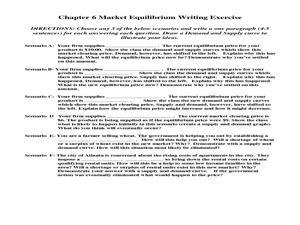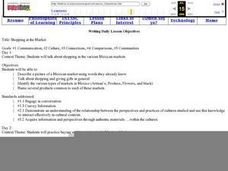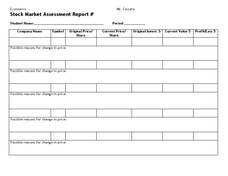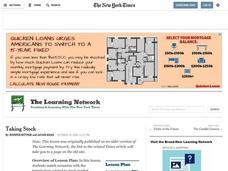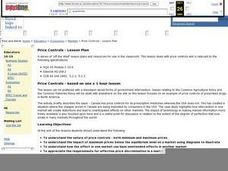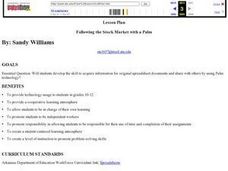Curated OER
Market Equilibrium Writing Exercise
In this economics learning exercise, students read 6 scenarios about market equilibrium and then select one of them to write about. Students draw demand and supply curves to accompany their written answers.
Curated OER
Shopping at the Market
Bring a Mexican marketplace to your classroom! Your middle schoolers will practice buying and selling items and learn more about marketplace culture. Set up booths with props beforehand, and consider adding a few products they're...
Curated OER
Market Structure and Competition
Students explore the role of government in the economy market. In this economics instructional activity, students analyze the decision making and how it takes into consideration additional cost, benefits and public awareness of what they...
Curated OER
Perfect Competition
Young economists consider perfect competition, market demand, supply, and long-run equilibrium in this practical learning exercise. There are eight multiple part questions to answer, real-world scenarios to consider, and graphs to complete.
Curated OER
How is the Game Played in an Economics Class?
Students research companies, choose stocks, and create portfolios online while playing the stock market game.
Curated OER
Market Supply and Demand and Equilibrium Prices
In this economics worksheet, learners respond to 27 fill and the blank and multiple choice questions about market supply and demand as well as equilibrium prices.
Curated OER
Oil Market Basics
Students explore the global oil market through a web-quest. In this oil market lesson plan, students conduct a web-quest to gather information related to the global oil market then design and make a mural.
Curated OER
Stock Market Assessment Report
In this stock market assessment report worksheet, students track the progress of share prices in the stock market using the provided graphic organizer.
Curated OER
What's the Price?
Fourth graders learn about price and comparative shopping. In this price and comparative shopping instructional activity, 4th graders read Amy Axelrod's, Pigs Go To Market: Fun with Math and Shopping. They use the book to investigate the...
Curated OER
Taking Stock
Students match scenarios with the terminology related to stock market fluctuations. They read an article, answer discussion questions, create a terminology poster, and write an essay.
Curated OER
Holiday Market Basket Information
Students practice with calculation of a price index using a fictitious market basket. They apply higher level problem-solving skills and develop an awareness of multicultural holiday rituals.
Curated OER
The Ups and Downs of the Stock Market
This is a one-page worksheet in which students practice working out the percentage changes in the stock prices of major corporations such as Sears, etc. This is useful in a business or economics lesson.
Curated OER
Running a School Bakery
Learners explore marketing concepts while producing food items to sell.
Curated OER
The Market System and Consumerism
Students examine their own consumption habits. Using various advertisements, they discuss their role in showing consumers what they must have in their lives. As a class, they encourage each other to change their habits and discuss how...
Curated OER
The Free Trade Conundrum: Balancing Worker Wages and Consumer Prices Comparing the 19th and 21st Centuries
By examining free trade, protectionism, and analyzing 19th and 21st century arguments for and against the tariff, students will be able to compare and contrast the 19th and 21st century. They will analyze text, answer discussion...
Curated OER
The Great Depression and FDR's New Deal
Find out about FDR's vision and the New Deal plan that helped pull America out of the Great Depression. The presentation focuses New Deal programs such as the Works Progress Administration, Agricultural Adjustment Administration, and the...
Curated OER
Dollars and Sense
Fourth graders read "Starting a Business" and answer the question: "How could you design an ad to let the community know about the business described in the story?" Then, they illustrate a written ad that could be posted in the...
College Board
2000 AP® Microeconomics Free-Response Questions
Monopolies may have an advantage in some markets, but what are they? A scaffolded problem set examines the effects monopolies have on a market. Other authentic College Board problems examine labor markets and how a variety of factors...
College Board
2012 AP® Microeconomics Free-Response Questions
A train company is experiencing losses. What happens if it raises prices: will it make up for its lost revenue, or wind up more deeply in the hole? Learners consider the dilemma, along with other questions regarding supply and demand...
College Board
2002 AP® Microeconomics Free-Response Questions
Inventors with patents have a distinct advantage in the market. But what happens when the patent expires? A series of questions from College Board asks learners to consider the effects of a patent expiration. Other practice prompts...
College Board
2001 AP® Microeconomics Free-Response Questions
How does one factor in the social costs of a product? What factors influence price? Learners consider the question and others using authentic College Board materials. Other questions examine profits and competition in the market and the...
Curated OER
Test Your Speaking And Listening Skills: A Fair Price?
In this consumer awareness activity, students look at a shopping list and write what is a fair price for each item and how much is the maximum they would be willing to pay. Students discuss their lists and may visit stores to see if...
Curated OER
Price Controls: Prescribed Drugs in North America
Students examine the nature of price controls, the impact of maximum prices below the equilibrium level on a market, the effect it can have on other markets, the requirements for effective price discrimination in a market, and the price...
Curated OER
Following the Stock Market With a Palm
Students research and explore the stock market. They research a three-year history of stocks, develop a group and individual spreadsheets, and follow their stocks and prices for a ten-day period, graphing the results.
